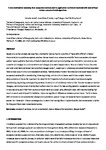A new method for assessing river ecosystem services and its application to rivers in Scotland with and without nature conservation designations.
| dc.contributor.author | Gilvear, David | |
| dc.contributor.author | Keele, V | |
| dc.contributor.author | angus, T | |
| dc.contributor.author | Philip Boon, | |
| dc.contributor.author | Large, A | |
| dc.date.accessioned | 2019-10-22T07:06:51Z | |
| dc.date.issued | 2019-09-11 | |
| dc.identifier.uri | http://hdl.handle.net/10026.1/15000 | |
| dc.description.abstract |
Based on a paired analysis, we describe a method for evaluating the potential of rivers with different physical characteristics to provide ecosystem services. Scores based on an extensive scientific literature review and expert opinion were applied to four sets of rivers in Scotland, with each pair comprising one river with a statutory nature conservation designation and one where such designations were largely absent. Data on physical habitat features and land cover were extracted manually from Google Earth™, based upon a previously published method expanded here to take account of cultural ecosystem services. Twenty physical habitat features and land-cover types and 13 ecosystem services (four provisioning, three regulating, and six cultural) were used in the analysis. Notable developments on the earlier approach included the full integration of cultural ecosystem services alongside provisioning, regulating and supporting services, introduction of confidence levels to river feature–ecosystem service linkages, and incorporation of valley floor surface area into one of the two scoring systems. Ecosystem scores for 500 m reaches along each river from source to mouth were calculated using Microsoft Excel, with results showing high reach-to-reach variability within individual rivers and significant differences between paired rivers. The four rivers with statutory nature conservation designations provided a greater range and typically higher ecosystem service scores than those with little or no designation, a result that has significant implications for river conservation and for framing catchment-level conservation policy. | |
| dc.language.iso | en | |
| dc.rights | Attribution-NonCommercial 4.0 International | |
| dc.rights | Attribution-NonCommercial 4.0 International | |
| dc.rights | Attribution-NonCommercial 4.0 International | |
| dc.rights | Attribution-NonCommercial 4.0 International | |
| dc.rights | Attribution-NonCommercial 4.0 International | |
| dc.rights.uri | http://creativecommons.org/licenses/by-nc/4.0/ | |
| dc.rights.uri | http://creativecommons.org/licenses/by-nc/4.0/ | |
| dc.rights.uri | http://creativecommons.org/licenses/by-nc/4.0/ | |
| dc.rights.uri | http://creativecommons.org/licenses/by-nc/4.0/ | |
| dc.rights.uri | http://creativecommons.org/licenses/by-nc/4.0/ | |
| dc.title | A new method for assessing river ecosystem services and its application to rivers in Scotland with and without nature conservation designations. | |
| dc.type | journal-article | |
| plymouth.journal | River Research and Applications | |
| dc.identifier.doi | 10.1002/rra.3533 | |
| plymouth.organisational-group | /Plymouth | |
| plymouth.organisational-group | /Plymouth/Faculty of Science and Engineering | |
| plymouth.organisational-group | /Plymouth/REF 2021 Researchers by UoA | |
| plymouth.organisational-group | /Plymouth/REF 2021 Researchers by UoA/UoA14 Geography and Environmental Studies | |
| plymouth.organisational-group | /Plymouth/Users by role | |
| plymouth.organisational-group | /Plymouth/Users by role/Academics | |
| dcterms.dateAccepted | 2019-08-02 | |
| dc.rights.embargodate | 2020-9-10 | |
| dc.rights.embargoperiod | Not known | |
| rioxxterms.versionofrecord | 10.1002/rra.3533 | |
| rioxxterms.licenseref.uri | http://creativecommons.org/licenses/by-nc/4.0/ | |
| rioxxterms.licenseref.startdate | 2019-09-11 | |
| rioxxterms.type | Journal Article/Review |



